Understanding Constipation
Before delving into enemas as a treatment option, it’s essential to understand what constipation is and what causes it. Constipation is characterized by infrequent bowel movements or difficulty passing stool. It can be caused by factors such as dehydration, lack of fiber in the diet, sedentary lifestyle, medications, certain medical conditions, and ignoring the urge to have a bowel movement.
What Are Enemas?
An enema is a procedure that involves introducing liquid into the rectum and colon through the anus. The liquid helps soften stool, lubricate the rectum, and stimulate bowel movements, thereby relieving constipation. Enemas can be administered at home or by healthcare professionals, depending on the severity of the constipation and individual preferences.
How Do Enemas Work?
Enemas work by stimulating the muscles of the rectum and colon, causing them to contract and expel waste. The liquid solution introduced into the rectum helps soften stool and lubricate the colon, making it easier for stool to pass. Additionally, the increased volume of liquid in the colon can trigger the body’s natural reflex to evacuate the bowels.
Types of Enemas
There are several types of enemas available, each with its own specific purpose and ingredients. Some common types of enemas include:
Saline Enemas
Saline enemas contain a solution of salt and water, which helps soften stool and promote bowel movements. They are gentle and generally well-tolerated.
Mineral Oil Enemas
Mineral oil enemas contain mineral oil, which lubricates the rectum and colon, making it easier for stool to pass. They are particularly useful for individuals with dry, hard stool.
Phosphate Enemas
Phosphate enemas contain sodium phosphate, which draws water into the colon, softening stool and stimulating bowel movements. They work quickly and are often used in hospital settings.
Tap Water Enemas
Tap water enemas involve using plain water to cleanse the colon and stimulate bowel movements. They are similar to saline enemas but may be less irritating to the rectum.
Coffee Enemas
Coffee enemas involve using a solution of coffee and water to stimulate bowel movements. Some proponents claim that coffee enemas can detoxify the body and improve overall health, but scientific evidence is lacking.
Using Enemas Safely
While enemas can be effective for relieving constipation, it’s essential to use them safely to avoid potential complications. Here are some tips for using enemas safely:
Follow Instructions Carefully
Always read and follow the instructions provided with the enema kit. Pay attention to the recommended dosage, volume of liquid, and administration technique.
Use Lukewarm Liquid
The liquid used for the enema should be lukewarm to avoid causing discomfort or injury to the rectum. Test the temperature of the liquid with your hand before administering the enema.
Use Lubricant
Apply a water-based lubricant to the tip of the enema nozzle to facilitate insertion and reduce discomfort.
Maintain Hygiene
Ensure proper hygiene by washing your hands thoroughly before and after administering the enema. Clean the anal area with soap and water before insertion.
Administer Slowly
Administer the enema solution slowly to allow the colon to absorb the liquid gradually. Rapid administration can cause discomfort or cramping.
Lie in Position
Lie on your left side with your knees bent while administering the enema. This position helps facilitate the flow of the liquid into the colon.
Hold the Liquid
After administering the enema, try to hold the liquid in the colon for a few minutes to allow it to soften stool and stimulate bowel movements.
Stay Hydrated
Drink plenty of water before and after using an enema to stay hydrated and support healthy bowel function.
Potential Risks and Side Effects
While enemas are generally safe when used as directed, there are some potential risks and side effects to be aware of. These may include:
- Rectal irritation or inflammation
- Bowel perforation (rare)
- Electrolyte imbalance
- Dehydration
- Dependency on enemas for bowel movements
If you experience severe or persistent side effects after using an enema, seek medical attention immediately.
FAQs
Are enemas safe for everyone?
Enemas may not be suitable for everyone, particularly individuals with certain medical conditions such as inflammatory bowel disease, hemorrhoids, or rectal prolapse. It’s essential to consult with a healthcare professional before using an enema, especially if you have underlying health concerns.
How quickly do enemas work?
The onset of action of an enema can vary depending on the type of enema used and individual factors such as hydration status and diet. In general, most enemas produce bowel movements within 5 to 20 minutes after administration.
Can enemas be used regularly?
While occasional use of enemas for constipation relief is generally safe, regular or frequent use of enemas can lead to dependency and may disrupt normal bowel function. It’s best to use enemas sparingly and focus on adopting lifestyle changes to promote regular bowel movements.
Are there any alternatives to enemas for constipation relief?
Yes, there are several alternative treatments for constipation, including dietary changes, increased fluid intake, fiber supplements, over-the-counter laxatives, and prescription medications. It’s essential to discuss your options with a healthcare professional to determine the most appropriate treatment for your individual needs.
Can enemas be used during pregnancy?
Enemas may be used during pregnancy under the guidance of a healthcare provider, but it’s essential to proceed with caution and use them only when necessary. Certain types of enemas may be safer than others during pregnancy, so it’s best to consult with a healthcare professional before use.
Can enemas cause dehydration?
In rare cases, enemas may cause dehydration if excessive fluid is absorbed into the colon, leading to electrolyte imbalance. It’s essential to stay hydrated before and after using an enema to minimize the risk of dehydration.
Can enemas be used for weight loss?
Enemas are not recommended for weight loss purposes and should only be used for their intended purpose of relieving constipation. Using enemas for weight loss can be dangerous and may lead to dehydration, electrolyte imbalance, and other health complications.
Conclusion
Enemas can be an effective treatment option for relieving constipation and promoting bowel movements. However, it’s essential to use them safely and judiciously, following proper techniques and guidelines. If you’re considering using an enema for constipation relief, be sure to consult with a healthcare professional to determine the most appropriate approach for your individual needs. With proper use and guidance, enemas can provide much-needed relief from constipation and improve overall gastrointestinal health.
- 7 Things to Know About the 500-Calorie Diet - May 1, 2024
- Sucrose vs Glucose vs Fructose: What’s the Difference? - May 1, 2024
- Benefits of Cucumber Water: 7 Reasons to Start Sipping - May 1, 2024

